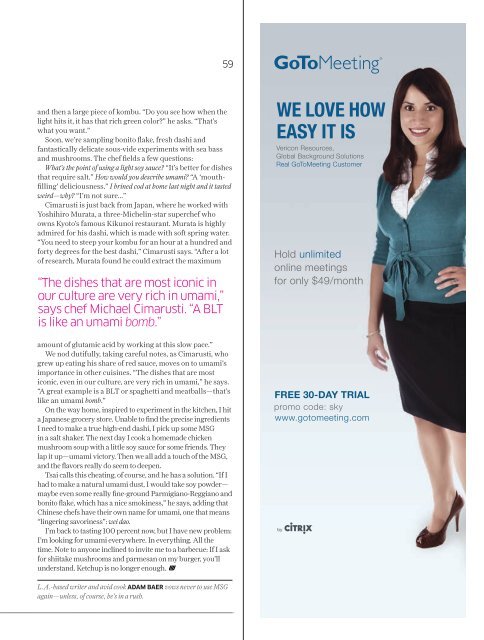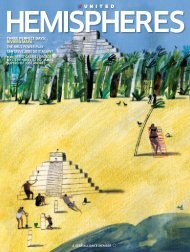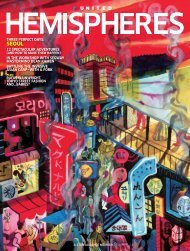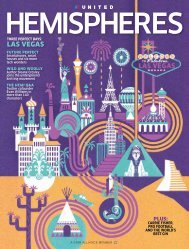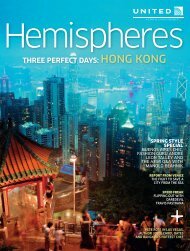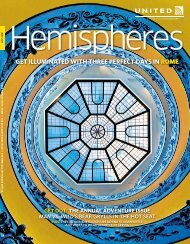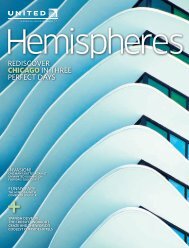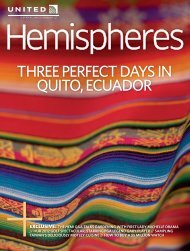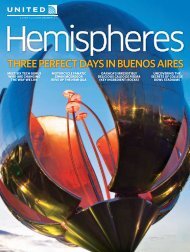june-2010
june-2010
june-2010
Create successful ePaper yourself
Turn your PDF publications into a flip-book with our unique Google optimized e-Paper software.
59<br />
and then a large piece of kombu. “Do you see how when the<br />
light hits it, it has that rich green color?” he asks. “That’s<br />
what you want.”<br />
Soon, we’re sampling bonito fl ake, fresh dashi and<br />
fantastically delicate sous-vide experiments with sea bass<br />
and mushrooms. The chef fi elds a few questions:<br />
What’s the point of using a light soy sauce? “It’s better for dishes<br />
that require salt.” How would you describe umami? “A ‘mouthfi<br />
lling’ deliciousness.” I brined cod at home last night and it tasted<br />
weird—why? “I’m not sure...”<br />
Cimarusti is just back from Japan, where he worked with<br />
Yoshihiro Murata, a three-Michelin-star superchef who<br />
owns Kyoto’s famous Kikunoi restaurant. Murata is highly<br />
admired for his dashi, which is made with soft spring water.<br />
“You need to steep your kombu for an hour at a hundred and<br />
forty degrees for the best dashi,” Cimarusti says. “After a lot<br />
of research, Murata found he could extract the maximum<br />
“The dishes that are most iconic in<br />
our culture are very rich in umami,”<br />
says chef Michael Cimarusti. “A BLT<br />
is like an umami bomb.”<br />
amount of glutamic acid by working at this slow pace.”<br />
We nod dutifully, taking careful notes, as Cimarusti, who<br />
grew up eating his share of red sauce, moves on to umami’s<br />
importance in other cuisines. “The dishes that are most<br />
iconic, even in our culture, are very rich in umami,” he says.<br />
“A great example is a BLT or spaghetti and meatballs—that’s<br />
like an umami bomb.”<br />
On the way home, inspired to experiment in the kitchen, I hit<br />
a Japanese grocery store. Unable to fi nd the precise ingredients<br />
I need to make a true high-end dashi, I pick up some MSG<br />
in a salt shaker. The next day I cook a homemade chicken<br />
mushroom soup with a little soy sauce for some friends. They<br />
lap it up—umami victory. Then we all add a touch of the MSG,<br />
and the fl avors really do seem to deepen.<br />
Tsai calls this cheating, of course, and he has a solution. “If I<br />
had to make a natural umami dust, I would take soy powder—<br />
maybe even some really fi ne-ground Parmigiano-Reggiano and<br />
bonito fl ake, which has a nice smokiness,” he says, adding that<br />
Chinese chefs have their own name for umami, one that means<br />
“lingering savoriness”: wei dao.<br />
I’m back to tasting 100 percent now, but I have new problem:<br />
I’m looking for umami everywhere. In everything. All the<br />
time. Note to anyone inclined to invite me to a barbecue: If I ask<br />
for shiitake mushrooms and parmesan on my burger, you’ll<br />
understand. Ketchup is no longer enough.<br />
L.A.-based writer and avid cook ADAM BAER vows never to use MSG<br />
again—unless, of course, he’s in a rush.<br />
WE LOVE HOW<br />
EASY IT IS


